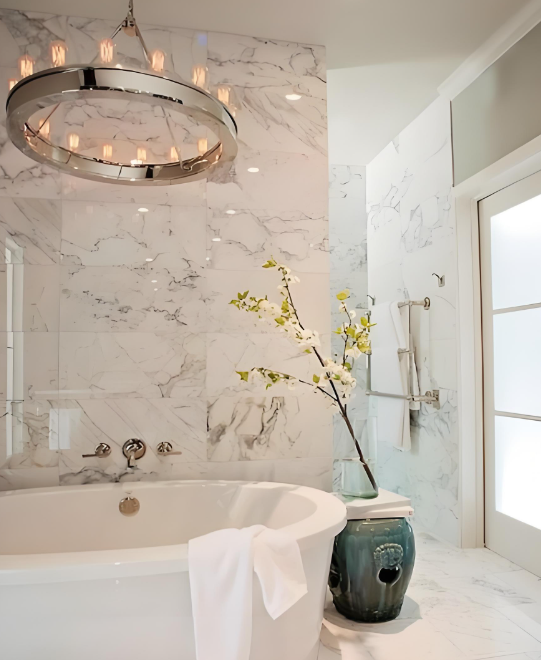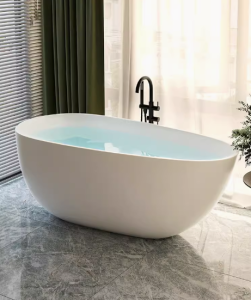
Natural Stone Bathtub Or Artificial Stone Bathtub? Make A Choice For Your Bathroom -
When you are ready to choose a bathtub for your home, you may face a dilemma: choose a natural stone bathtub or a man-made stone bathtub? Whereas man-made stone bathtubs are useful and lovely, natural stone bathtubs are exquisite and noble. Though they have rather different performance and features behind them, both are pleasing. So, which one is the best choice for you? We shall next contrast these two bathtub materials from an innovative angle to guide your choice.

Natural stone bathtubs show natural texture and unique beauty
Gift from nature: natural stone bathtub
The charm of natural stone bathtubs lies in its direct connection with nature. Usually, they are carved from naturally occurring stones such sandstone, granite, and marble. Like a piece of sculptural art, every natural stone bathtub has a different design that lends natural texture and distinctive beauty to the bathroom area.
1. Visual effect and texture
The texture and color of natural stone cannot be replicated, and each bathtub is unique, which has become one of the main reasons why many people love it. The bathroom can have rather great visual value from the soft touch of sandstone, the firm texture of granite, and the graceful marble. This kind of artistic existence reflects a taste of life as well as a location for bathing.
2. Durability and Maintenance
Another great thing about natural stone is its durability. Families looking for a long-lasting, sturdy item will find stone to be a wonderful alternative since it is hard and spans a great period. Natural stone does, nevertheless, also provide certain difficulties, particularly with regard to care. Most natural stones are porous, hence they readily absorb dirt and moisture. Long periods of time without cleaning or regular maintenance may cause surface damage or mold. Furthermore, natural stone bathtubs are often hefty, thus while installing the floor’s load-bearing capacity should be given some thought.
3. Health and Environmental Impact
Natural stone comes from nature and does not contain harmful chemicals, so it is a healthy choice from the material’s essence. Its porosity, however, makes it prone to bacterial breeding if neglected, thereby posing certain health hazards. In addition, the mining process of natural stone may have a certain impact on the environment, so in terms of environmental protection, it is important to choose a stone that has been certified sustainable.

Natural stone bathtub adds great visual value to the bathroom
Artificial stone bathtubs: Technology’s power
Compared to natural stone, artificial stone bathtubs are made through modern technology and synthetic materials. Usually composed of resin and natural stone powder, it not only preserves the beauty of natural stone but also maximizes its use. It’s a simpler, more affordable choice with maintenance ease.
1. Diverse designs and appearances
One of the advantages of artificial stone bathtubs is its diverse designs. Artificial stone can have more color and texture choices but seem almost like natural stone using artificial synthesis technologies. Your house style will determine the colors you choose; from pure white to dark black, from plain modern to natural simulation style, and the choosing space is really broad. Artificial stone bathtubs can also be made into various shapes according to different molds, with higher design flexibility.
2. Easy maintenance and cost advantages
Compared with natural stone, artificial stone is more durable and easy to maintain. Usually specifically prepared, imitation stone bathtubs have strong anti-fouling and anti-scratch properties; they are not easily penetrated water, which is quite handy for cleaning. The bathtub will stay brilliant and clean for a long period with just basic daily cleaning. Furthermore, artificial stone bathtubs are easier to install and lighter than genuine stone bathtubs; so, floor load-bearing concerns like those of natural stone bathtubs are not relevant.
In terms of price, artificial stone is usually cheaper than natural stone, suitable for consumers with a limited budget. Furthermore very reasonably cost-effective in terms of service life are artificial stone bathtubs because of their durability and simplicity of maintenance.
3. Health and environmental factors
Although artificial stone bathtubs use chemical materials such as resins in the production process, modern production processes usually ensure that these materials meet environmental standards. Artificial stone bathtubs are actually rather hygienic since their smooth, non-porous surface helps to prevent filth accumulation by means of which bacteria are avoided. At the same time, many artificial stone products are now made of recycled materials, further reducing the burden on the environment.
Bathtub made of artificial and real stone comparison
We may directly compare some important areas to help you better grasp the variations between the two:
1. Aesthetics
Natural stone bathtubs often give people an unrepeatable visual experience due to their unique natural texture. Every stone piece is different, which gives the bathroom a high-end and distinctive impression. Although fake stone bathtubs can also replicate the texture and look of actual stone, their texture is typically more homogeneous and some customers could feel that they lack “soul”. Artificial stone’s design versatility, however, is a benefit if you want a straightforward, modern look.
2. Lifespan and durability
Granite and marble are among the highly hard and durable natural stones, but they need constant cleaning and sealing to stop water stains and bacterial entrance. Artificial stone’s impermeability makes everyday maintenance simpler and its longevity is just as great. The inexpensive maintenance of artificial stone bathtubs could appeal more to time-pressed households.
3. Hygiene and health
Artificial stone bathtubs are less likely to breed bacteria due to their smooth, non-porous surface, and are more hygienic. If not sealed and cleaned, natural stone could start to attract mold and bacteria. Natural stone bathtubs must thus be kept more regularly and carefully if one wants to keep a clean and sanitary bathtub surroundings.
4. Price and cost
Natural stone bathtubs are generally more expensive than artificial stone bathtubs due to the high cost of mining, processing and transportation. On the other side, thanks to better manufacturing techniques, artificial stone is really reasonably priced. Furthermore, whilst artificial stone bathtubs are simpler to install, the weight of natural stone increases installation expenses.
5. Environmental friendliness
While artificial stone—especially those produced from recycled materials—has higher environmental performance, the mining process of natural stone might harm the surroundings. Consequently, artificial stone could be a more sustainable option if you especially worry about environmental problems.

natural stone bathtub
Whether you choose a natural stone bathtub or an artificial stone bathtub, both have their unique advantages. Natural stone bathtubs provide unparalleled natural beauty and luxury experience, but require more maintenance and a high budget. Conversely, with their varied shapes, low upkeep, and reasonably priced construction, artificial stone bathtubs have grown to be a common choice for modern houses.
When making a decision, you can weigh it according to your personal needs, budget and lifestyle. After all, a bathtub is a place for you to unwind and savor life as much as a place to have a bath. Whatever one you decide upon will provide you an amazing bathing experience.
Frequently Asked Question (FAQ)
How to install a marble bathtub?
Installing a marble bathtub requires careful planning and attention to detail. First, choose the right location for the bathtub, ensuring it has a strong structure and is not too heavy. Ensure the floor is flat to prevent instability and leaks. Move the bathtub with help, preferably a professional, to avoid damage. Install the drainage system, ensuring a complete seal and a professional plumber for any plumbing knowledge. Test the water flow and drainage system, ensuring smooth water flow and stability. Seal the bathtub with a waterproof sealant to prevent leaks and ensure long-term use. Install the faucet and shower, ensuring a tight and seamless interface. Add decorative elements like scented candles, soft bath towels, and green plants for a warm and comfortable bathroom. Consider accessories like anti-slip mats and bathtub pillows for added comfort. Although installing a marble bathtub may be time-consuming, the luxurious experience it brings is worth it.




